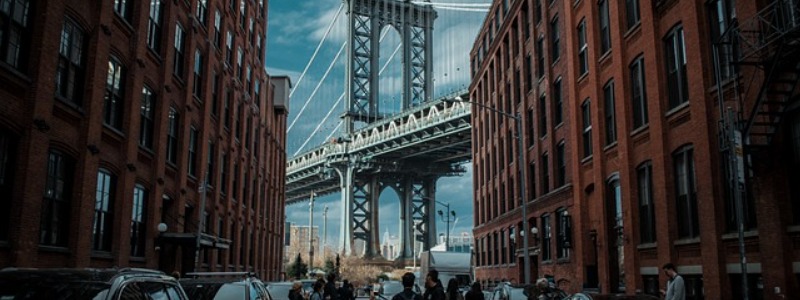Stretching more than 1,400 feet over the East River, the Manhattan Bridge connects Brooklyn with Manhattan. Opened in 1909, this historic suspension bridge carries vehicles, pedestrians, bicyclists, and subway trains. Overlooking the famous skylines of The Big Apple, the Manhattan Bridge is also one of the most photographed subjects of Lower Manhattan. Approximately three-quarters of the total traffic on this busy bridge involves public transportation. It was the last of the three suspension bridges built across the lower East River, following the Brooklyn Bridge and Williamsburg Bridge.
Sightseeing
The Manhattan Bridge has walkways for pedestrians and bicyclists for recreational and commuting purposes. These paths are lined with tall wired fences for safety purposes, but you can still enjoy great views of the East River, New York Harbor, Lower Manhattan, and Brooklyn.
If you’d like a panoramic view of the actual bridge, you should head to the DUMBO district. Occupying the northern tip of Brooklyn, Main Street Park and Empire Fulton Ferry Park are waterfront green spaces that overlook this famous suspension bridge. Both of these parks also offer great views of boats that slowly navigate the East River.
On the Manhattan side, the Murry Bergtraum softball field also offers unobstructed perspectives of the bridge. Sightseeing cruises along the East River pass under the bridge, and helicopter tours fly over the structure. Additionally, the adjacent Brooklyn Bridge is a great spot for glancing at the Manhattan Bridge.
History and Facts
Lower Manhattan was the hub of New York City’s financial industry and other sectors in the early 20th century. The city’s leaders proposed the construction of another crossing between this part of the borough and Brooklyn. It seemed that the existing Williamsburg Bridge and Brooklyn Bridge couldn’t handle the growing traffic over the East River.
Construction on the bridge began in 1901, and the simple name was based on Manhattan. One of the nation’s top structural engineers, Leon Solomon Moisseiff took a leading role in the design of the project. The suspension concept was prevalent in the country, so he integrated this configuration into the Manhattan Bridge. The Warren Truss was an innovative component that was included in the design of this new link between Manhattan and Brooklyn. Moisseiff later participated in the design of the George Washington Bridge, which is the busiest water crossing in the world.
The Manhattan bridge opened to the public at the end of 1909, and the first users were a few dozen pedestrians from the newly incorporated borough of Brooklyn. In fact, this suspension bridge was initially designed to accommodate pedestrians and subway trains rather than vehicles.
Throughout the years, the New York City Department of Transportation has made significant expansions and renovations to account for growing vehicle traffic. For example, approximately 800 million dollars were spent on road improvements.
Visiting Manhattan Bridge
The Manhattan Bridge has seven total lanes that are dedicated to vehicle traffic. Four lanes occupy the upper deck, which opened in the 1920s. All of the lanes on the lower deck have one-way traffic heading into Lower Manhattan. This level also has walkways for pedestrians and a dedicated bike lane with Class 1 classification. According to the NYC DOT, this suspension bridge carries approximately half a million commuters each day.
The B, D, N, and Q trains of the New York City Subway also run over the Manhattan Bridge. These rapid transit lines provide convenient connections between Manhattan and Brooklyn. The elevated rail tracks on the bridge are unique because most of the subway system has an underground infrastructure.
Location: crosses the East River in New York City, connecting Lower Manhattan at Canal Street with Downtown Brooklyn
Click to visit the Manhattan Bridge official website.

